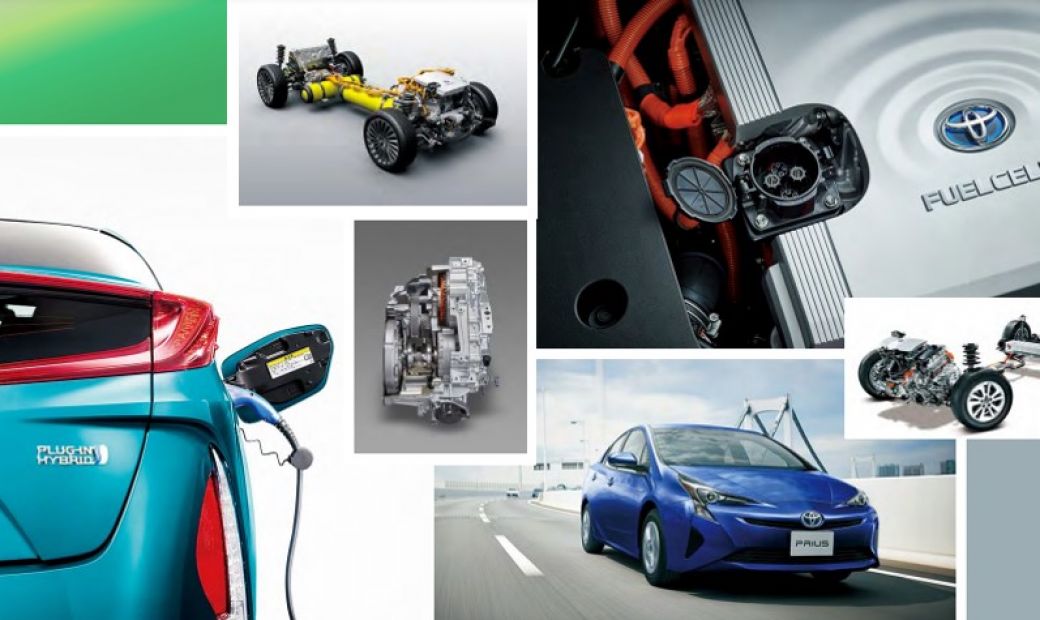Please fill in some of the data provided below to receive the latest Toyota-related news and information in your email.


Carbon Neutrality and Toyota Global Commitment
Based on Toyota's philosophy: “Mobility and Happiness for all” all of Toyota's business, manufacturing and development activities adhere to this philosophy. For more than 80 years, Toyota has lived up to its vision and mission to mass produce happiness, and bring safe, sustainable, mobility technologies to customers globally.
As part of that mission, Toyota continues to strive to help all countries and regions around it achieve carbon neutrality through its products.
In addition, Toyota is 100% committed to achieving carbon neutrality by 2050 or earlier.
Carbon Neutrality for the automotive industry
Carbon neutrality for the automotive industry means achieving zero CO2 emissions in all processes throughout the vehicle's life cycle from manufacturing, delivery, use, refueling and/or powering, and recycling and disposal (when the vehicle is no longer in use).
Toyota has been innovating and investing in technologies to reduce emissions and achieve carbon neutrality for more than 30 years. In the early 1990s, Toyota committed to achieving the ambitious goal of building a vehicle that would have twice the fuel efficiency of a Corolla-class vehicle with the same high reliability and low cost Toyota customers had come to expect. There was a lot of skepticism at the time.
In 1996, Toyota developed and launched its first battery electric vehicle, the RAV4 EV. This RAV4 EV model faces significant challenges related to its limited cruising range, long charging times and lack of available charging infrastructure.
But Toyota engineers used customer feedback and valuable knowledge from the development of the RAV4 EV to improve its battery power technology and system electronics. In 1997, Toyota launched the Prius model, the world's first mass-produced hybrid electric car (Hybrid Electric Vehicle/ HEV). Bringing HEVs to market is not an easy practice. This involves many innovations in motors, inverters, engines, batteries, and electronics.
Some of Toyota's innovations in battery technology include materials, manufacturing processes, improved safety and accident due diligence, performance of generated power, and recycling for sustainable manufacturing.
Based on that experience, over the past 25 years, Toyota has remained committed to developing a series of new technologies and products to help reduce carbon emissions.
“We have successfully developed and launched a wide range of innovative products including a hybrid electric vehicle (HEV), a battery electric vehicle (BEV), a plug-in hybrid electric vehicle (PHEV), and an electric vehicle. hydrogen fuel cell (Fuel-Cell Electric Vehicle / FCEV)”, said James Kuffner, Toyota Motor Corporation's Chief Digital Officer when delivering a presentation regarding Toyota's global efforts to contribute to achieving carbon neutrality last August 2021.
Electric Vehicles from Toyota
The success of the Prius demonstrates that Toyota's commitment to carbon neutrality also creates once-in-a-generation opportunities for innovation and market leadership. Today, Toyota offers a line of 55 models of electric cars that are practical, reliable and affordable.
Going forward, Toyota will introduce a wider selection of electric vehicles in the future, to provide more options for consumers around the world. Toyota's combined sales volume of electric vehicles, including HEV, BEV, PHEV and FCEV, currently stands at more than 2 million vehicles per year.
“The Atkinson cycle engine in our HEV and PHEV models is very efficient - up to about 40%. These efficiency improvements have helped reduce emissions in many parts of the world, especially those with less environmentally friendly electrical infrastructure,” added Kuffner.
The net positive impact of Toyota's innovations allows for cumulative carbon emission reductions of about 140 million tons over 20 years (total estimate). This is equivalent to removing 1.5 million ordinary passenger vehicles from the road each year over that time period. With this achievement, Toyota is committed to be able to do even better. That is why Toyota will introduce 15 battery electric vehicle models globally by 2025, including the seven recently announced TOYOTA bZ models.
In addition, Toyota is also expanding and improving the product lineup of HEV, PHEV, and FCEV. To support these new products, Toyota will continue to invest globally in exciting new battery technologies, such as solid state batteries. Along with a more efficient electric motor, the new battery will help develop electric cars that are more practical, safer and more sustainable.
Toyota Strategy, Sustainable Investment and Commitment to Achieving Carbon Neutrality
Toyota believes the world can achieve Carbon Neutrality, but there are still many challenges in realizing this shared dream. Even with the perfect battery technology, BEVs will still produce tons of CO2 emissions if charged by electricity generated by coal or other non-renewable energy sources.
Another challenge is that not everyone has easy access to the charging infrastructure. "I'm one of them. I live in an apartment building in Tokyo, and don't have the ability to plug in a vehicle. Fortunately, Toyota was able to offer me an additional option. For example, PHEV offers flexibility. The PHEV can be driven in a zero-emission electric mode, optimized for short trips as well as providing a hybrid mode for longer trips”, Kuffner shared his personal experience.
Hydrogen Fuel Cell Alternative
Toyota continues to invest aggressively in new green energy aiming to achieve carbon neutrality.
This makes Toyota a leader in Hydrogen Fuel Cell (FCEV) technology. Hydrogen is the most abundant element in the universe and can be produced locally at the point of use with nothing but renewable energy and water. Hydrogen can also provide long-term renewable energy storage for use even if its use is at its peak.
After more than 20 years of research and development, in 2014, Toyota unveiled the Mirai, the first mass-produced hydrogen fuel cell electric vehicle, which won the 2016 World Green Car of the Year award.
The fuel cell technology is truly unique. As the vehicle moves, air from outside combines with the Hydrogen in the fuel cell to produce electricity and water. This zero-emission vehicle can be recharged in three minutes.
Toyota introduced the second generation Mirai in December 2020. In this latest generation of Mirai, Toyota improves performance, comfort and efficiency, and increases the EPA (Environment Protection Agency) cruising range to 647 km.
Despite these improvements, hydrogen energy still faces many challenges in terms of infrastructure availability, overall efficiency, and low-cost (eco-friendly) clean hydrogen production. Toyota will continue to invest in technology to address these challenges. Moreover, passenger cars are only a small part of Hydrogen's future potential. Toyota's hydrogen fuel cell technology can play a part in helping achieve a clean transportation ecosystem around the world. This means achieving carbon neutrality in trucks and heavy transport, trains, buses, taxis, aviation, shipping, forklifts, and industrial processes, all of which combine to emit more CO2 than passenger cars.
Toyota has also developed a modular fuel cell and a “self-contained” fuel cell generator that can be repositioned to generate electricity anywhere, on demand. For example, you can use Toyota's self-contained fuel cell generator to create a charging station for a BEV or PHEV.
More Environmentally Friendly Internal Combustion Engine (ICE) Vehicles
There are currently more than 1.4 billion vehicles in the world and most of them have internal combustion engine (ICE) technology. Toyota is exploring possible ways to “clean up” (make it more environmentally friendly) world heritage ICE vehicles that will still be operational for the next 10-15 years.
Hydrogen fuel can also be one of the cleaner burning options. In July 2021, Toyota demonstrated a prototype of a new hydrogen engine that could expand options to achieve carbon neutrality more quickly.
In the world of motorsports, where new technology is developing at a rapid pace, President Akio Toyoda, who is an expert driver, gets right down to the wheel and repeatedly evaluates the vehicle and its technological advances.
Toyota's task of making an "ever-better car" also has the potential to enable even more environmentally friendly motorsport.
Commitment to Achieving Carbon Neutrality
Toyota has a strong commitment to Carbon Neutrality. Toyota has the largest and fastest growing lineup of electric vehicles in the world, consisting of: BEV, HEV, PHEV and FCEV. Due to nearly 25 years of historical experience working with electrification, Toyota has world-class technology and a strong position to help countries around the world reduce emissions and achieve Carbon Neutrality faster. This was all done before the recent government mandated regulations or global movements and the growing awareness of the need for Carbon Neutrality.
Giving back to the world, and having a clean future, is in DNA
Electrified VehicleMedia/Journalist Contact : [Memuat email...]
Non Media / Non Journalist Contact : [Memuat email...]

© 2024 Toyota Motor Manufacturing Indonesia. All Rights Reserved.
